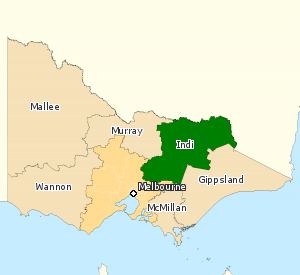Division of Indi
|
Indi Australian House of Representatives Division |
|
|---|---|

Division of Indi in Victoria, as of the 2016 federal election.
|
|
| Created | 1901 |
| MP | Cathy McGowan |
| Party | Independent |
| Namesake | Murray River (Aboriginal name) |
| Electors | 103,784 (2016) |
| Area | 28,567 km2 (11,029.8 sq mi) |
| Demographic | Rural |
The Division of Indi /ˈɪndaɪ/ is an Australian Electoral Division in northeastern Victoria. The largest settlements in the division are the regional cities of Wodonga, Wangaratta, and Benalla. Other towns in the electorate include Rutherglen, Mansfield, Beechworth, Myrtleford, Bright, Alexandra, Tallangatta, Corryong and a number of other small villages (notably including the ski resort of Falls Creek). While Indi is one of the largest electorates in Victoria, much of it is located within the largely uninhabited Australian Alps. While Wodonga serves as a regional hub for much of the more heavily populated northern part of the electorate, the southern part is closer to Melbourne than Wodonga.
Indi has existed continuously since Federation. It was created in 1900 and was one of the original 75 divisions contested at the first federal election. The most nationally prominent person to represent Indi to date was the first, Sir Isaac Isaacs, who rose to become Attorney-General of Australia, Chief Justice of the High Court of Australia, and the first Australian-born Governor-General of Australia. Another member for Indi, John "Black Jack" McEwen, was a long-serving Minister and was briefly Prime Minister of Australia after the death of Harold Holt in 1967, but he was member for Murray by then. Indi has been held by a member of a conservative party (either the Liberal Party and its predecessors or the National Party) or a conservative independent for all but four terms since Federation, and without interruption since 1931. Labor last won the seat in 1928 when the Country incumbent forgot to renominate, and retained it in 1929. Since 2004, the Liberal primary vote has been in decline, falling from 63% in 2004, to 54% in 2007, 53% in 2010, 44% in 2013 and 27% in 2016.
...
Wikipedia
